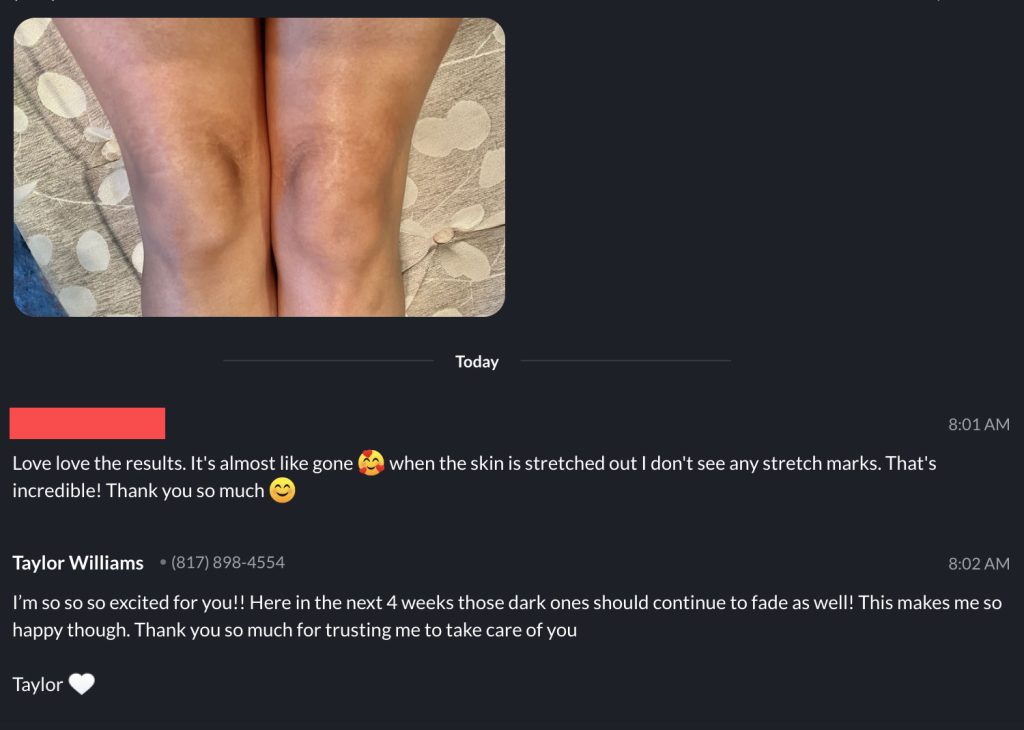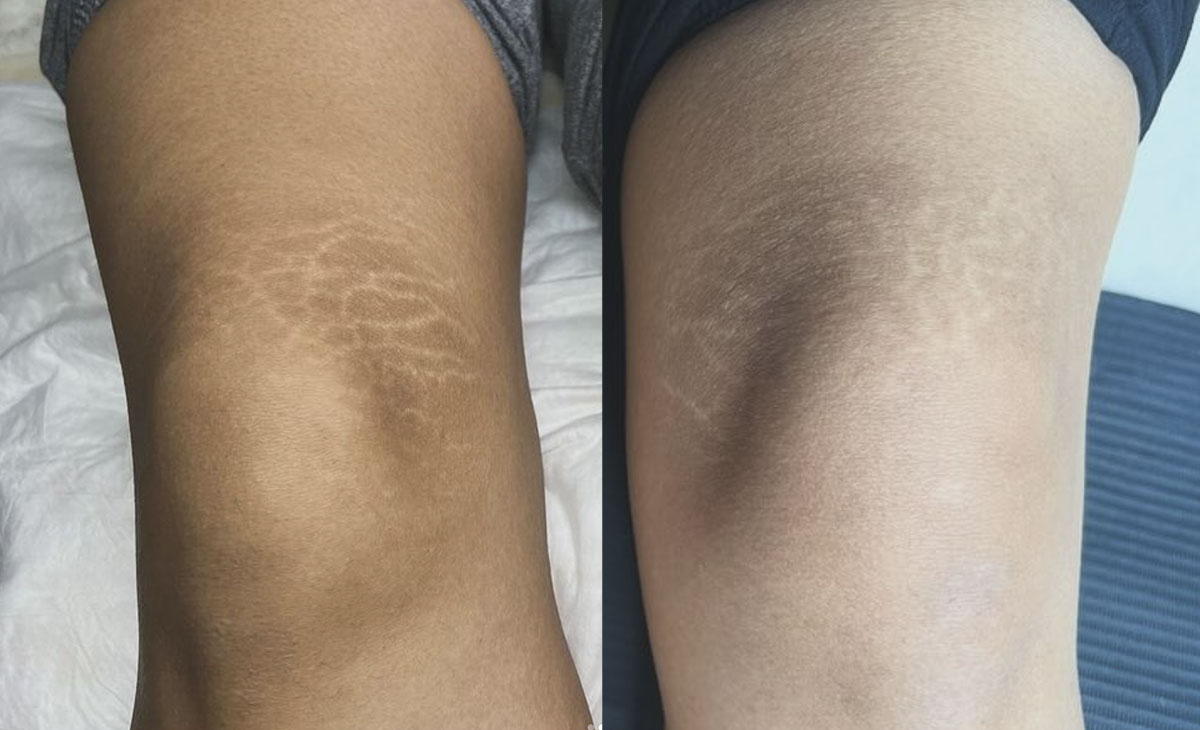Having knee stretch marks can make you self-conscious about your appearance. About 50% to 90% of people experience these marks during their lives. This article offers solutions and preventive measures for this common issue.
Causes and Symptoms of Knee Stretch Marks
Rapid body growth, quick weight gain, and high levels of steroids often lead to the appearance of knee stretch marks. These factors cause the skin to stretch beyond its capacity, resulting in tears beneath the surface known as striae distensae.
Puberty and conditions like Cushing syndrome or Marfan syndrome can also contribute to their development. As our bodies undergo various physical changes, these unavoidable processes sometimes leave visible marks on areas around the knees.
Newly formed knee stretch marks may initially feel slightly raised against the skin and can be itchy. They show up in a variety of colors ranging from pink, red, black, blue to purple depending on one’s skin tone but tend to fade over time into a more silvery hue.
Recognizing these symptoms early aids individuals in seeking appropriate care and treatment options from professionals or exploring effective home remedies for managing their appearance.
Effective Treatments for Knee Stretch Marks
Discovering effective treatments for knee stretch marks opens the door to improved confidence and skin appearance. From advanced laser therapies to innovative camouflage techniques, numerous options provide hope and relief for those seeking solutions.
Prescription creams and laser treatments
Prescription creams offer a targeted approach to reducing the appearance of knee stretch marks. Products containing tretinoin, also known as Retin-A, have shown efficacy in fading these marks by stimulating skin regeneration and collagen production.
It’s crucial for individuals to apply these creams consistently over time to see improvements.
Laser treatments, including pulsed dye laser therapy, fractional CO2 laser therapy, and excimer laser therapy, provide another effective option for those seeking to diminish knee stretch marks.
These procedures work by promoting new skin growth and enhancing skin texture at the site of stretch marks. Each type of laser treatment has its unique benefits and works best on specific types of stretch marks; thus, consulting with a medical professional can help determine the most suitable option based on individual needs.
Laser therapies often require multiple sessions for optimal results and can be expensive depending on the area and size of the stretch marks.
Microneedling and Retinol Creams
Microneedling, a process that involves tiny needles piercing the skin to prompt its natural healing response, pairs well with retinol creams for reducing knee stretch marks. This combination not only stimulates collagen production but also improves skin texture and elasticity, making it an effective treatment option.
Retinol creams complement microneedling by enhancing skin renewal and addressing issues like wrinkles and hydration levels.
Retinol, a derivative of vitamin A found in over-the-counter anti-aging products, plays a crucial role in improving the appearance of knee stretch marks when used consistently alongside microneedling treatments.
These methods work together to diminish the visibility of scars and marks by accelerating skin regeneration and supporting overall skin health.

Stretch Mark Camouflage
Stretch mark camouflage offers a unique approach to dealing with knee stretch marks by blending them into your surrounding skin. Professionals, like Scar Camo, use special pigments to tattoo over the stretch marks, making them less noticeable.
At Scar Camo, the first step is normally an ink-less treatment to help stimulating skin regeneration and collagen production. Similar to the mircroneedling and laser treatments. Depending on the stretch marks, we have had clients that have seen significant results without needing to move forward with the scar camouflage blending treatments.
For some stretch marks, this ink-less treatment doesn’t remove the striae but effectively reduces and flattens them, which gives your skin a more uniform appearance.
If needed, the next step would be applying skin tone ink, to the stretch marks which blends the stretch marks to the surrounding skin.
It’s especially popular among those who have tried other treatments without success or are looking for a non-invasive solution. Creams, laser treatments and microneedling can all go so far!
Unlike lasers or creams, camouflage provides an instant improvement in the look of stretch marks, boosting confidence in one’s physical appearance.
Preventive Measures against Knee Stretch Marks
Preventing knee stretch marks requires a combination of maintaining a healthy weight and caring for your skin. Here are several proactive steps to help minimize the appearance of these marks before they start.
- Stay at an optimal weight: Avoid rapid weight gain or loss, which can cause the skin to stretch quickly and lead to stretch marks.
- Use centella and hyaluronic acid products: These ingredients increase moisture and elasticity in the skin, helping to prevent stretch marks from forming.
- Keep your body hydrated: Drinking plenty of water keeps your skin supple and less prone to stretching. Aim for at least 8 glasses a day.
- Maintain a balanced diet: Eating foods rich in vitamins C, D, E, zinc, and protein supports skin health by building collagen and promoting regeneration.
- Exercise regularly: This helps improve circulation and ensure a steady increase in muscle mass without rapid stretching of the skin.
- Limit caffeine intake: Too much caffeine can dehydrate your body, making your skin more prone to stretching. Consider reducing coffee consumption.
- Moisturize daily: Applying moisturizing creams or oils regularly increases the elasticity of the knee area to withstand stretching.
- Engage in strength training cautiously: If you’re into weightlifting, gradually increase weights to avoid sudden changes that might strain and mark your knees.
- Choose clothes wisely: Wear comfortable clothing that doesn’t constrict movement or blood flow, especially around your knees.
- Consult with professionals if needed: If you have conditions like Ehlers-Danlos syndrome (EDS) that make you more susceptible to stretch marks, seek advice from healthcare providers on personalized prevention strategies.
By integrating these measures into your daily regimen, you can significantly reduce the risk of developing knee stretch marks, keeping your skin healthy and resilient against common causes of scarring and striae gravidarum.
Contact Scar Camo
Embracing a journey toward smoother skin doesn’t have to be overwhelming. Exploring treatments like stretch mark camouflage offers hope for those seeking to diminish knee stretch marks.
Prevention, focusing on maintaining a healthy lifestyle, stands as the first line of defense. With persistence and the right approach, achieving noticeable improvements is within reach.
The key lies in finding a treatment plan that works best for your unique situation, setting you on a path toward increased confidence and comfort in your own skin.
FAQs: Knee Stretch Mark Treatments
1. What are the best treatments for knee stretch marks?
The most effective treatments for knee stretch marks include stretch mark camouflage, laser skin resurfacing and topical creams specifically designed to reduce their appearance. These methods help improve skin texture and promote healing.
2. Can self-tanners help camouflage knee stretch marks?
Yes, self-tanners can temporarily camouflage stretch marks by evening out the skin tone around them, making them less noticeable. However, this is a cosmetic solution and does not treat the stretch marks themselves.
3. Are there any preventative measures for knee stretch marks?
Maintaining healthy skin through regular moisturization and using products containing ingredients like gotu kola can strengthen the skin’s elasticity, potentially preventing the formation of new stretch marks on the knees or elsewhere on the body.
4. Should I consult a doctor before treating my knee stretch marks?
Consulting with a dermatologist or plastic surgeon is advisable before starting any treatment regimen for knee stretch marks. They can diagnose your specific condition and recommend the most effective clinical practice options tailored to your needs.
5. How do pregnancy and physical health conditions affect knee stretch mark development?
Pregnant women often experience rapid stretching of the skin around areas like the abdomen and knees, leading to potential development of stretch marks due to hormonal changes that weaken skin fibers. Conditions such as varicosities (varicose veins), eczema, psoriasis, or significant weight fluctuations also contribute to their formation by similarly stressing the skin’s elasticity.


